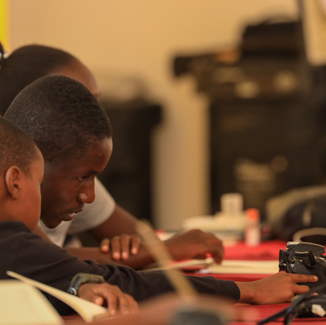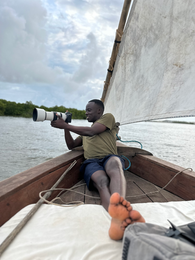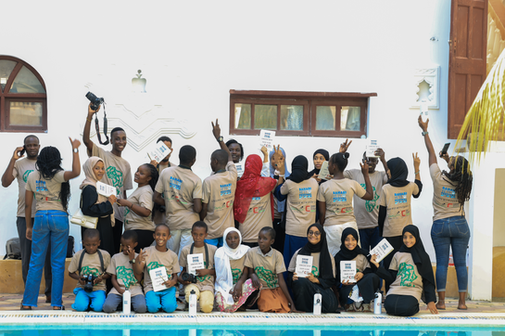How To Do Shots Right And Tell A Story
- eve
- Sep 3, 2024
- 4 min read

Why would one need to have extensive photography skills to tell conservation stories? Why is it important to use digital cameras when high-tech phones are accessible to anybody interested? After all, these cameras are expensive, bulky and complex to operate, right? Also, why bring kids to the storytelling photography conversation? These questions raced through my mind as I prepared for the week. Are we really teaching kids to shoot for a living?

From the 19th-23rd August 2024, the TonyWild Foundation conducted a successful week-long photography workshop on 20 of our children and youth from the Lamu Archipelago. This professional training was sponsored by The Portuguese Embassy, in preparation for our upcoming Bahari Yetu Festival come October 9th and 10th, 2024.
The first day began with rather shy kids coming in, excited for what was to come. It was interesting to learn that of the 20, only 5 had interacted with a digital camera before.

TonyWild trainers; Vicky, Beryl, Toby and Elsie did a thorough job taking the class through every key detail there is to know about a digital camera. By the end of day, all students could not only define terms but also handle cameras appropriately, fix lenses and detach them from cameras for proper storage. It was only a matter of time before these kids started shooting left right and center.
For days 2 and 3, the classes were all about the best photography angles to use, how to adjust manual mode ISO, aperture and shutter speed settings as well as how to observe the rule of a third during a photoshoot. We incorporated the skill of storytelling and explored how it comes in handy as one shoots for content. The trainers’ aim was for the kids to know how to take a photograph that will make any viewer feel the way they do when they read the line of a poem twice. I tell you what, it worked!
When we went to the Palm Garden at Peponi Hotel for practice, I saw images that evoked my emotions at first sight! The students used all sorts of postures and positions to get the right angles to capture images. Some were lying flat on the ground for the worm-eye angle to get a picture that screams prominence, while others took elevated positions to capture images from the bird-eye angle to obtain detailed pictures of the subject and the ocean background clearly. Trainers were beaming with pride. The hardest part of this practical was getting kids to bring back the cameras because they did not want the photography session to end, and the garden was bewitchingly beautiful.

For day 4, we covered ethics and elements of conservation photography. For a conservation story project, we had the students shadow our very own waste management program.

While showing off their merchandise, the class walked the narrow streets of Shela and the beach, documenting all kinds of waste in sight, their sources and their collection. I was particularly impressed by the shy kids who asked for consent from random people to take photos of them and their businesses, for the environment conservation project we were working on.

Thereafter, we trekked to Kijitoni Dumpsite where LaMCoT and SERG collaboratively sort waste for further action. The students caught the team members in action; sorting the organic, metallic, glass and plastic waste into their respective piles. This was the second stage of their conservation story; knowing where the waste goes and who manages it.
For the final bit, we all jumped on boats and cruised to The FlipFlopi, an NGO renowned for their projects in recycling plastic waste. The journey there was so interesting and calming, we almost lost track of time. We were mesmerized by the FlipFlopi boats made from recycled plastic; one of which uses an electric motor in place of a diesel one to promote eco-friendliness. On arrival, we were taken through the process of plastic waste management, and the students documented it all. Most of them left on a mission to stop their family members from using single-use plastics to conserve the environment, seeing how much work goes into cleaning it up.
The last day was spent going through the post-production process. We outlined the challenges encountered shooting the previous day, among them being batteries and storage space running out, time flying, unpredictable weather conditions, name it, and how to conquer these. As we were exploring photo editing software and techniques; it came out clear as day that photographers have to deal with a lot of crop, pun intended!

The students reviewed some of their images, which will be used to determine who among them took the best shots. Yep; it was a competitive class! The best photographers will be awarded generously during the 2024 Bahari Yetu Festival - Watoto Day, so make sure you attend to see.
We ended the 5-day workshop with a fun filled afternoon. The new photographers in town talked excitedly about how they would practice and monetize their skill in the near future. They enjoyed a swim for hours before we gathered for a cake-cutting session. Later in the evening, Lamcot and Tonywild teams boarded the dhows for a breathtaking sunset sail.
We had given the kids the ability to freeze time, and use the photos as a return ticket to a moment otherwise gone. What is more, they can tell visual conservation stories professionally. If I were to describe that whole week in one word, it was e-pic!
Written by Evelyn Kimori, LaMCoT
Photographed by TonyWild Foundation & Evelyn Kimori

















































































